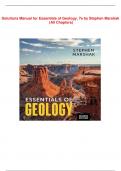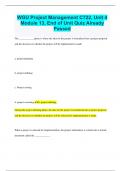Solutions Manual for Essentials of Geology, 7e by Stephen Marshak
(All Chapters)
PR
O
FD
O
C
, CHAPTER 1
The Earth in Context
Learning Objectives
1. Students should be aware of the Big Bang theory. Distant galaxies are all moving
away from us. The farthest galaxies are receding from us the fastest. All matter in the
PR
Universe was contained in a single point, approximately 13.8 billion years ago. At
that time, the Universe explosively came into existence.
2. Stars, including our Sun, are nuclear-fusion reactors. For most of their life histories
(on the order of billions of years), hydrogen atoms are fused together to form helium.
O
Later stages in stellar evolution include fusion of helium atoms and other, heavier
elements; ultimately, iron is the heaviest element that can be produced through fusion
FD
reactions within stars.
3. After their cycles of fusion are complete, large stars violently explode (forming
supernovas), producing elements heavier than iron and leaving behind a residue of
diffuse nebulae, which may be recycled to form a new star at some future point.
O
4. Our Solar System is approximately 4.57 Ga (billion years old). All eight planets
revolve around the Sun in coplanar, elliptical orbits. All planets orbit in the same
C
direction (counterclockwise, as viewed from above Earth’s North Pole). These facts
imply simultaneous planetary formation from a swirling nebula surrounding the Sun
(the similarities in orbits would then be a natural result of conservation of angular
momentum). The planets accreted from this nebula through gravitational attraction
and haphazard collisions. Pluto, long considered the “ninth planet,” has seen its status
demoted; astronomers now recognize eight major planets.
5. The terrestrial planets (Mercury, Venus, Earth, and Mars) are relatively small, dense,
and rocky worlds. The giant planets are predominantly composed of the light gases
hydrogen and helium (Jupiter and Saturn) or ices (Uranus and Neptune); they are
, much larger and much less dense than the terrestrial planets.
6. Our Moon is thought to have originated from debris accumulated when a protoplanet
collided with Earth approximately 4.53 Ga.
7. The Earth System is subdivided into the atmosphere (gases and aerosols that envelop
the planet), hydrosphere (Earth’s water), geosphere (solid Earth), and biosphere
(living things).
8. Earth is chemically divided into a thin, rocky crust dominated by silicate minerals, a
thick mantle composed mostly of iron- and magnesium-rich silicates (subject locally
to partial melting), and a thick, metallic core made primarily of iron (the outer portion
of which is liquid). Students should know how seismic waves tell us that the outer
core must be liquid.
9. Physically, the uppermost layers of Earth are the rigid lithosphere (crust and
PR
uppermost mantle) and the asthenosphere, which is weaker and flows plastically. The
“plates” of plate tectonics theory are discrete slabs of lithosphere, which move with
respect to one another atop the asthenosphere.
O
FD
Summary from the Text
O
The geocentric model placed Earth at the center of the Universe. The heliocentric
model placed the Sun at the center.
The Earth is one of eight planets orbiting the Sun. The Solar System lies on the outer
C
edge of the Milky Way galaxy. The Universe contains hundreds of billions of galaxies.
Most astronomers agree that this expansion began after the Big Bang, a cataclysmic
explosion that occurred about 13.7 billion years ago.
The first atoms (hydrogen and helium) of the Universe developed within minutes of
the Big Bang. These atoms formed vast gas clouds, called nebulae.
Only very small atoms formed during Big Bang nucleosynthesis. The Earth, and the
life forms on it, contain elements that could have been produced only during the life cycle
, of stars—intermediate-sized atoms formed by fusion during supernovae explosions.
Thus, we are all made of stardust.
Gravity caused clumps of gas in the nebulae to coalesce into flattened disks with
bulbous centers. As the central ball of this accretionary disk collapsed inward, it became
a warm protostar. Eventually, the ball became so hot and dense that fusion reactions
began, and it became a true star.
Planets developed from nebulae, the rings of gas and dust surrounding newborn
stars. Matter in these nebulae condensed into planetesimals, which then clumped together
to form protoplanets, and finally, true planets. Inner rings became the terrestrial planets;
outer rings grew into giant planets, which consist mostly of gas and/or ice.
The Moon formed from debris ejected when a protoplanet collided with Earth in the
young Solar System.
PR
When a protoplanet grows large enough, it eventually becomes warm enough inside
to differentiate into a core and mantle, and then to assume a near-spherical shape when it
becomes so soft that gravity can smooth out irregularities.
The Earth has a magnetic that shields it from solar wind and cosmic rays.
O
A layer of gas surrounds the Earth. This atmosphere, which consists of 78% N2,
21% O2, and 1% other gases, can be subdivided into layers. Air pressure decreases with
FD
increasing elevation.
The surface of Earth can be divided into land (30%) and ocean (70%). Most of the
land surface lies within 1 km of sea level. Earth’s land surface has a great variety of
O
landscapes due to variations in elevation and climate.
Earth materials include organic chemicals, minerals, glasses, rocks, melts, and
C
volatiles. Most rocks on Earth contain silica (SiO2). We distinguish among various basic
rock types based on the proportion of silica.
The Earth’s interior can be divided into three distinct layers: the very thin crust, the
rocky mantle, and the metallic core.
Pressure and temperature both increase with depth in the Earth. The rate at which
temperature increases as depth increases is the geothermal gradient.
The crust is a thin skin that varies in thickness from 7–10 km (beneath oceans) to
25–70 km (beneath the continents). Oceanic crust is mafic in composition, whereas





